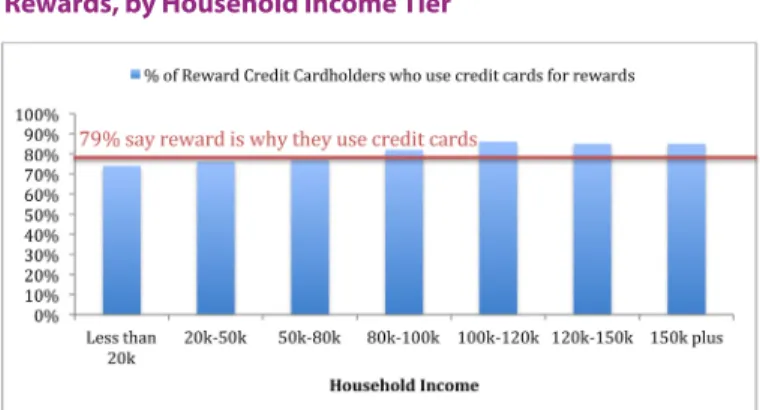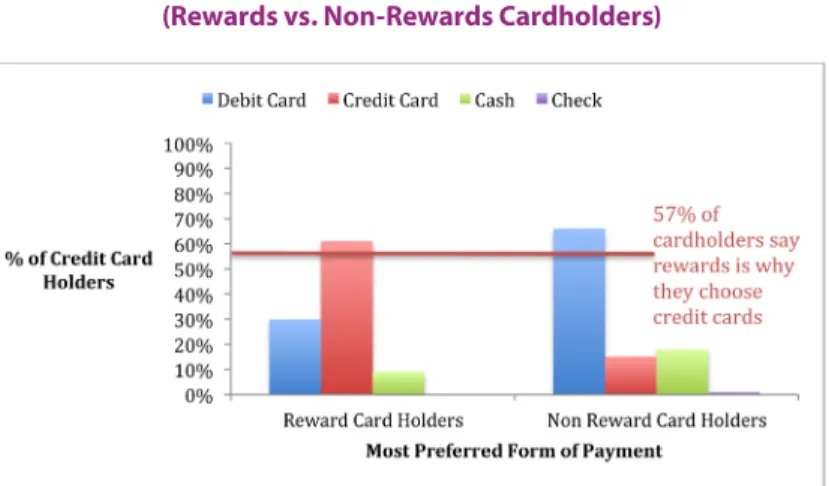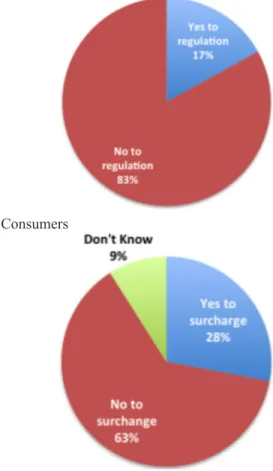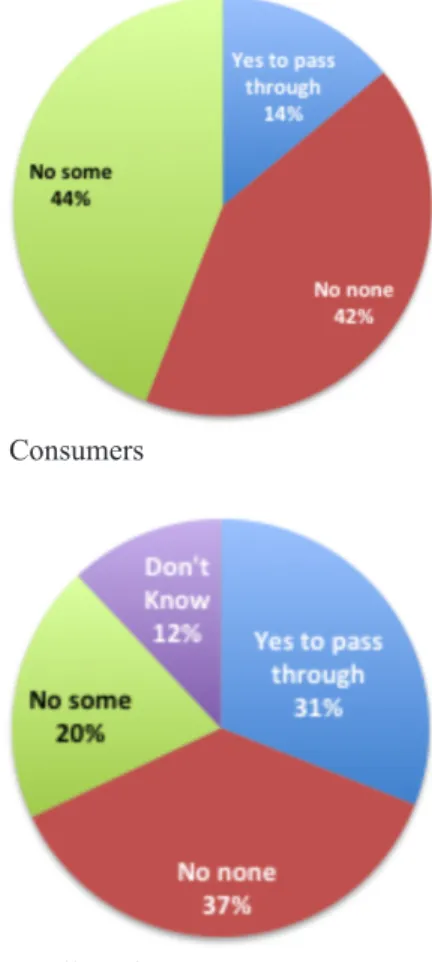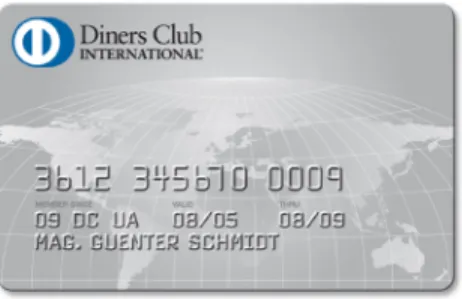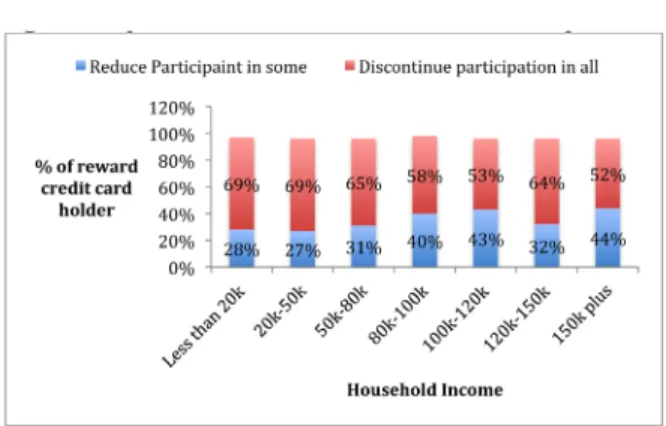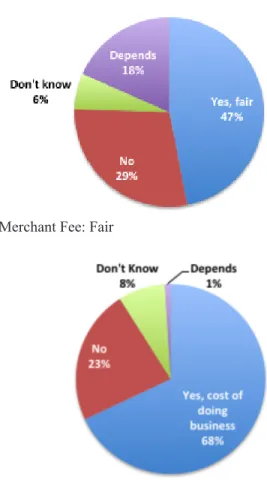August 2012
By: Michael A. Turner, Ph.D., Patrick Walker, M.A. and Katrina Dusek, M.A.
RESULTS AND SOLUTIONS
March 2009
New to Credit from
Alternative Data
First, Do No Harm:
A White Paper on Cardholder and Small Business Operator Views
About Credit Card Fees and Surcharges
Copyright: © 2012 PERC Press.
All rights to the contents of this paper are held by the Policy & Economic Research Council (PERC).
No reproduction of this report is permitted without prior express written consent of PERC. To request hardcopies, or rights of reproduction, please call: +1 (919) 338-2798.
August 2012
First, Do No Harm:
A White Paper on Cardholder and Small Business Operator Views
About Credit Card Fees and Surcharges
Acknowledgments
We wish to thank the American Bankers Association (ABA) for their grant that enabled us to
undertake this research. In addition, we wish to thank Joseph Duncan, Walter Kitchenman, and
Whytney Pickens for their insights, input, and edits to this series of white papers.
Table of Contents
Introduction 6
The Extent and Popularity of Rewards Programs 7
Consumer and Small Business Operator Views on Proposed Policy Changes 8
Some Unintended Consequences That Consumers and Small Business Operators Have Considered and Regulators Have Not 13
6
First, Do No Harm: A White Paper on Cardholder and Small Business Operator Views About Credit Card Fees and Surcharges
Introduction
The 2008 financial crisis provoked an extensive
reform of financial sector policy. The Dodd-Frank
Act, the CARD Act, the Durbin Amendment on
interchange fees for debit cards, and the newly
created Consumer Financial Protection Bureau
(CFPB) all constitute significant changes
affect-ing the credit card industry. Other measures are
being considered in addition as the debt crisis
continues. One such area for reform are credit
cards that offer rewards, such as one percent cash
back to the credit card user or airline miles.
Proposals to change current policy on merchant fees and the ability of merchants to levy surcharges on rewards cards call for a careful assessment of this issue. Proponents of reform argue that rewards programs are costly to credit card issuers (such as banks). Credit card issuers, in turn, recoup some or all of these costs by passing them along to merchants and their customers via fees (including interchange fees) and other income. Merchants, unable to levy a surcharge for credit cards or rewards cards recover the cost of the higher interchange fee by passing these costs on to all consumers—regardless of payment method—in the form of higher overall prices. Some advocates and regulators argue that credit card rewards programs have the characteristics of a “Reverse Robin Hood” scenario. That is, instead of taking from the rich to give to the poor they take from the poor and give to the rich. They point out that wealthier Americans, who also hold more equity in financial services
institutions, disproportionately use credit cards and rewards programs, and thus disproportionately benefit from their costs being spread out to others and the profits they earn.
A recent report by Scott Schuh, Oz Shy, and Joanna Stavins at the Federal Reserve Bank of Boston calculates that “each cash-using household pays $151 to card-using households and each card-using household receives $1,482 from cash users every year [a total transfer of $1,633 from the average cash payer to the average card payer].” And they also find that the lowest income households pay $21 while the highest income house-holds receive $750. As such, lower-income Americans effectively subsidize the card use and rewards programs of wealthier Americans.
If this were true—and the merits of this Reverse Robin Hood claim for rewards programs are contestable—one would expect strong public support for policy designed to rectify business practice. Therefore, PERC conducted a survey of consumers and merchants to determine the support for proposed policies to address the Reverse Rob-in Hood effect. While PERC did not query noncardhold-ers on this matter, it did solicit opinions from cardholdnoncardhold-ers and small business operators from lower-than-average income areas about such a policy prescription. One would presume that the most vocal supporters of reforms would be lower-income cardholders, who either don’t use cards enough to qualify for any meaningful rewards or who perceive the fees they pay to exceed the value of the rewards they receive. In addition, small busi-ness operators should support policy changes aimed at
1 Merchants can, however, offer customers discounts for their payment choices. This is essentially (mathematically) the equivalent of be able to
surcharge.
2 Scott Schuh, Oz Shy, and Joanna Stavins, “Who Gains and Who Loses from Credit Card Payments? Theory and Calibrations.” Public Policy
Discussion Paper No. 10-03. (Boston: Federal Reserve Bank of Boston, August 31, 2010), available at http://www.bos.frb.org/economic/ppdp/2010/ ppdp1003.pdf
7
PERC August 2012
lowering the interchange fees charged, and these changes should be especially supported by smaller merchants from lower-income areas, whose customer base most likely prefers cash and as such would be below-average rewards card users. But that is not what we found.
The Extent and Popularity of
Rewards Programs
A large majority of credit card holders in our survey, across all income tiers and small business operators— those groups whom proponents of reform argue should support fees and surcharges for credit cards and rewards cards — not only strongly opposed policy changes (such as surcharging and other credit card and rewards use fees), but also saw great value in rewards programs. In short, participation in credit card rewards programs is robust, satisfaction levels are high, and respondents did not want the government to fix what is widely viewed as a nonexistent problem.
As Figure 1 illustrates, among the 2,000 cardholders recently surveyed by PERC and Opinion Research Corporation (ORC), at least 7 in 10 participated in a
3 PERC/ORC Survey of 2000 Credit Cardholders of which 1589 were reward cardholders. It was an online survey. The PERC Business Survey was
a telephone survey of 556 small business operators in the gulf coast states of Louisiana, Florida, Alabama and Mississippi.
4 Emily Jane. “Top 10 Consumer Complaints” Fox. July 2012. http://finance.yahoo.com/news/top-10-consumer-complaints-144500757.html
Figure 1: Rewards Program Participation Rates by Household Income
rewards program across all income levels, with more than 8 in 10 participating in the higher-income brackets. The vast majority of both high-income cardholders and low-income cardholders participate in a rewards program.3
Perhaps more compelling than the high rewards program participation rates among all income brackets is the fact that 8 in 10 of those participants use their credit cards primarily because of rewards programs. Figure 2 shows that there is very little difference among income tiers in the explanation for credit card use.
Source: 2012 PERC/ORC Survey
Figure 2: Percent Who Use Credit Card Primarily for Rewards, by Household Income Tier
Source: 2012 PERC/ORC survey
Taken together (high rewards program participation rates and rewards programs as primary drivers for card use), these facts create a classic case of a disconnection between stated preferences—what people believe about credit cards in general—and revealed preferences— what people actually do.4 The most common example of
this is voter attitudes toward Congress. Currently, the public approval rating of Congress is at an all-time low, teetering just above single digit approval. Yet, if history holds, approximately 9 in 10 incumbents up for election will be re-elected.
8
First, Do No Harm: A White Paper on Cardholder and Small Business Operator Views About Credit Card Fees and Surcharges
The same can be said of public attitudes toward the credit card industry—or even an individual card com-pany—versus individual preference for using a credit card and participating in credit card rewards programs. Generally, consumers dislike the card industry and in-dividual card companies—their distaste is possibly only surpassed by that for Congress. 5 However, as is shown
in Figure 3, individual cardholders prefer to pay for purchases with their rewards cards over other payment methods by a large margin. And as is shown in Table 1, reward cards are used more than any other rewards pro-gram, and have the highest customer satisfaction rate.
Figure 3: Preferred Payment Medium (Rewards vs. Non-Rewards Cardholders)
Source: 2012 PERC/ORC survey
Cardholders select and use cards owing to rewards programs (and other benefits of using credit cards), and credit card rewards programs have the highest satisfac-tion level among all rewards programs.
Let’s set aside the fact that rewards programs of all types are intricately woven into the fabric of the modern American economy, that rewards programs have a long history of acceptance by consumers, are ubiquitous
across industries, and almost always involve some degree of cross-subsidy from nonparticipants to participants, all else being equal. And let’s also overlook the seeming willingness of some to single out an individual industry rewards program for different treatment than the myri-ad rewards programs offered in other industries. Finally, let’s also ignore that in this specific industry, there may not be a cross-subsidy as there may also be costs of cash that noncash users finance, and that retail prices may be lowered for all consumers as a consequence of increased revenue to merchants from rewards card users, as all else is not equal.
PERC thoroughly addresses the merits of the facts, findings, and conclusions from the Schuh, Shy, and Stavins reports separately.6 In the balance of this paper,
however, the focus is limited to the views and opinions of the two key stakeholders in this policy matter— consumers and small business operators.
Consumer and Small Business
Operator Views on Proposed Policy
Changes
During the first quarter of 2012, PERC and ORC Inter-national surveyed 2,501 consumers (2,000 cardholders, and 501 noncardholders) on a range of topics relating to credit cards and rewards programs. The sample was reflective of the adult population by every meaningful sociodemographic variable including race/ethnicity, income, age, gender, and geography.
At the same time, PERC surveyed 538 small busi-ness operators on their views about the same issues. The small businesses surveyed were located in the Gulf Coast region (Alabama, Florida, Louisiana, and Mississippi)—an area that has been hit hard by natural disasters, the BP oil spill, and the Great Recession.
5 Eric Folgate, “Another Reason For Me to Hate Credit Cards.” Money Crashers website.
http://www.moneycrashers.com/another-reasone-for-me-to-hate-credit-cards/
9
PERC August 2012
These states also have very large minority and lower income populations, and therefore provide a strong test case for several key assumptions advanced by advocates of reform—that merchants will pass through savings from a reduced interchange fee to consumers and that merchants believe interchange fees are unfair.
Perhaps the most startling finding from this survey was the extent to which respondents—both cardholders and small business operators—absolutely opposed the policy prescriptions that were suggested by reform proponents. As is clear in Figure 4, nearly 85% of all cardholders opposed allowing merchants to charge different prices for different payment options (e.g., one price for cash, another for credit cards, another for debit cards, another for checks). Most consumers reported that merchants would abuse such a practice, while many others believed such a pricing scheme would be overly complicated.
FIGURE 4: Cardholder Support for Merchant Price Discrimination
Source: 2012 PERC/ORC survey.
Small business operators also strongly dislike pricing by payment method. As Figure 5 shows, 72% of small business respondents were opposed to charging their customers different prices if they paid by cash, credit card, debit card, or check. Given comments from respondents to the telephone survey, this is likely driven by two primary concerns: to avoid confusing customers; and to avoid upsetting customers who pay with credit cards.
These are highly valued customers. Merchants report that cardholders—particularly rewards cardholders— spend more on average than those who pay with other means.7 While 25% of small business operators reported
a preference for charging different prices according to payment method, the survey includes some firms that are primarily business-to-business, which would face less of a backlash from customers given the predomi-nance of noncash payments.
FIGURE 5: Small Business Operator Views on Pricing by Payment Method
7 Three-fourths of small business operators reported that accepting credit cards increases sales, and 50% reported that rewards card holders spend
more than nonreward cardholders. PERC survey 2012.
Source: 2012 PERC Business survey.
10
First, Do No Harm: A White Paper on Cardholder and Small Business Operator Views About Credit Card Fees and Surcharges
Given the strength of the opposition to pricing by pay-ment method by both cardholders and small business operators, the pronounced opposition to surcharges on card users and rewards program participants by both is unsurprising. Figure 6 shows that large majorities of cardholders (83%) and small business operators (63%) unequivocally oppose surcharges, while just 25% of small business operators favor such a measure. As with the earlier finding regarding pricing by payment meth-od, small business operators who value customers using credit cards (especially rewards program participants who spend more on average) want to avoid consumer confusion or upsetting their customers.
FIGURE 6: Consumer and Merchant Attitudes toward Regulation of Reward Cards and Surcharge on Use of Credit Cards
Source: 2012 PERC/ORC survey and PERC Business survey.
8 GAO. Credit Cards: Rising Interchange Fees Have Increased Costs for Merchants, but Options for Reducing Fees Pose Challenges. November 2009.
One of the most significant drivers of cardholder op-position to a surcharge by merchants on credit card purchases is the fact that most don’t believe that they will see any benefit. For the surcharge policy prescription to have the intended effect—of reversing the alleged cross-subsidy—merchants would have to adjust prices storewide to reflect a reduced factor cost, as card users and not merchants would now be directly paying for some or all of the interchange fee. This is what is called “passing through” savings.
Proponents of a surcharge solution assume that mer-chants would pass through 100% of the savings from the reduced cost of doing business directly to consum-ers. Consumers are skeptical of this harmonious out-come. In the PERC/ORC survey of cardholders, 86% disagreed with the 100% pass through assumption, with 42% responding that merchants would keep all of the savings as a windfall profit while simultaneously increasing costs for cardholders.
Consumers
11
PERC August 2012
It turns out their skepticism is well placed. On the basis of both their own statements and evidence from abroad, most merchants are highly unlikely to pass all or even some of their savings on to their customers.8,9 As shown
in Figure 7, in the PERC/ORC survey, fewer than one-third of small business operators (31%) reported that they would fully pass savings on to their customers, while more than one-third reported that they wouldn’t pass any savings on to their customers, and just 1 in 5 (20%) reported that they would pass some of the sav-ings on to customers.
This presumption by consumers and business owners is, in fact, what happened in Australia, where since 2003 surcharges on credit card purchases are allowed. Lawmakers in Australia argued that forcing merchants to assume interchange fees was anticompetitive, and passed a law permitting surcharges in the belief that merchants would simply recover costs.
Somewhat predictably, merchants in Australia did not accord themselves with the happy assumptions of Australian lawmakers. Instead, they used their newly granted right to impose surcharges as an additional revenue generating tool, charging their customers with a surcharge (2.55%) that averages three times the inter-change fee (0.81%).10 In addition, there is no evidence
that merchants reduced prices to reflect their savings— the pass-through scenario.11 Thus, at least in Australia,
a decade of evidence suggests that when equipped with the right to levy a surcharge on customers, merchants do not pass through savings, and in many cases will price gouge instead.
9 Bradsher, Keith. 2009. U.S. Looks to Australia on Credit Card Fees.
http://www.nytimes.com/2009/11/25/your-money/credit-and-debit-cards/25card.html?_r=2&hp=&pagewanted=all
10 Angus Kidman, “Are Credit Card Surcharges Out of Control?” LifeHacker Australia. March 15, 2011.
http://www.lifehacker.com.au/2011/03/are-credit-card-surcharges-out-of-control/
11 See Howard Chang, David Evans, and Daniel Garcia Swartz, “The Effect of Regulatory Intervention in Two-Sided Markets: An Assessment of
Interchange-Fee Capping in Australia,” Review of Network Economics.4 (4): December 2005.
FIGURE 7: Consumer and Merchant Attitudes on Pass-Through of Potential Savings
Source: 2012 PERC/ORC survey and PERC Business Survey.
Consumers
12
First, Do No Harm: A White Paper on Cardholder and Small Business Operator Views About Credit Card Fees and Surcharges
Another policy prescription offered to rectify the Reverse Robin Hood outcome is to simply charge card users a fee for the privilege of having a credit card. Similarly, rewards cardholders would be charged an ad-ditional fee for having elected to enroll in a credit card rewards program. This approach, as with the surcharge proposal, has a track record in a number of markets. Many merchants charge a fee for “membership” in discount clubs (e.g., Sam’s Club) or to be “preferred customers” who automatically receive discounts on all purchases and other select benefits.
While consumers have accepted this model under certain circumstances in some markets, in the case of credit cards in the United States, charging fees for credit card usage and card reward program participation will not be well received and will decidedly affect cardholder behavior. There is near universal opposition among all cardholders, regardless of income tier, to charging fees for card usage and reward cards. As depicted in Figure 8, more than 90% of respondents to the PERC/ORC survey were opposed to this proposed option. Such strong and pervasive opposition, if challenged (by the imposition of fees) will likely lead many cardholders to rebel.
FIGURE 8: Consumer Attitudes toward Fees for Use or Rewards Program Participation
Source: 2012 PERC/ORC survey.
As is evident in Figure 9, the imposition of fees on re-wards cardholders will most likely lead these consumers to either discontinue using rewards cards altogether, or reduce their use of rewards cards—as they did in Aus-tralia. While card purchases remained relatively con-stant, cardholders in Australia dramatically increased the volume of debit card purchases. Proponents of this solution will argue that this is doubly good, as it will conceivably (at least partially) remedy a perceived social injustice and will result in better financial management as more consumers transact with cash or other payment means. But in Australia, whether or not this is better financial management is unclear. The increase in debit card transactions appears to have come at the expense of cash and checks, and not credit cards.
In the United States, there is reason to believe that a surcharge or fees on credit and rewards cards would affect cardholder spending patterns. More than 9 in 10 respondents to the PERC/ORC survey reported they would either entirely discontinue reward card use (an average of 60% across income tiers) or would reduce use (an average of above 30% across income tiers).
Schuh, Shy, and Stavin at the Federal Reserve in Boston assume that there will be no reduction in consumption, and that consumers will merely substitute other pay-ment means for credit cards.12 This is a dubious
assump-tion. Both cardholders and small business operators reported that they tend to spend more, on average, and in many cases much more, when buying with a credit card—especially rewards cards—than when buying with cash or other payment means.
13
PERC August 2012
Source: 2012 PERC/ORC survey.
Some Unintended Consequences
That Consumers and Small Business
Operators Have Considered and
Regulators Have Not
The big question for policymakers to consider when assessing whether promoting fees for cardholders and rewards cardholders would in fact lead to a socially op-timal outcome—an elimination of the ostensible cross-subsidy without harming the economy—is whether and to what degree it would result in a permanent contrac-tion in consumer spending.
Figure 10 includes a range of potential economic impacts that may result from a systematic policy of charging fees for rewards cards. There is good reason to believe that should merchants impose a surcharge on rewards cards, the economic consequences would be similar. Given the significance of the retail sector to the American economy, and the share of merchant revenue accounted for by highly valued rewards cardholders and credit card users, even very small changes in cardholder spending would have big consequences for the retail sector and the economy as a whole.
Figure 10: Estimated Impacts from Reductions in Reward Card Spending
Figure 9: Estimated Impacts from Reductions in Reward Card Spending
Change in Rewards Card Spending
Impact on GDP Impact on Jobs
–1% (0.07%) (100,000) –5% (0.35%) (500,000) –10% (0.70%) (1,000,000) –20% (1.40%) (2,000,000) –60% (4.20%) (6,000,000)
For example, a 1% reduction in reward card spend-ing would result in a 0.07% reduction in U.S. gross domestic product (GDP) and the loss of 100,000 jobs. In a reworking of the measure of cross-subsidy, the case most similar to that estimated by Schuh, Shy, and Stavins, low-income households pay, on average, $29 to higher-income households. The addition of a modest impact on sales changes the direction of the subsidy. Assume a modest 1.3% cost for cash and an increase in total merchant sales of 1% (amounting to 5% of credit cards sales) with the acceptance of credit cards. In this scenario, low-income households receive, on average, $6 from high-income households. The Reverse Robin-Hood subsidy is reversed. Larger increases in sales from credit cards result in larger cross-subsidies to cash users. Given that 6 in 10 rewards cardholders reported that they would discontinue using rewards cards entirely, and given that rewards cardholders spend more, on average, than those paying with nonrewards cards and other payment methods, a 5% reduction in credit card sales seems very conservative. There will be some substi-tution effect, and consumer spending using alternative payment methods will increase, partially offsetting the decline in rewards card spending. How much this offset will be is an open question, but that 5% of lost credit card sales will not be offset is a safe assumption.
14
First, Do No Harm: A White Paper on Cardholder and Small Business Operator Views About Credit Card Fees and Surcharges
Although this is a largely speculative exercise, we can infer an outcome given certain facts. First, nearly 7 in 10 noncardholders responding to the PERC/ORC survey reported that debit cards were their preferred payment mechanism. Second, more than 6 in 10 cardholders stated that their preferred payment mechanism was a credit card, and slightly fewer than 6 in 10 indicated that rewards programs were the primary reason they used a credit card for purchases. Given the sheer number of cardholders indicating either discontinued or diminished use of rewards cards, we would expect a sizable minor-ity of rewards cards holders to behave more like noncard holders. In all likelihood, many rewards cardholders may no longer hold credit cards in response to a reward card fee or surcharge. This is what happened in Australia, as the value of credit card purchases declined and debit card purchases increased. Because credit card users spend more, on average, than noncardholders, the surge in debit card spending will likely be less than the drop in credit card spending.
Figure 12 summarizes the cardholder and small busi-ness operator opposition to the policy prescriptions. Cardholders—the very customers who merchants value the most—are vehemently opposed to either paying a fee for using a credit card or a rewards credit card, or facing a merchant surcharge. Interestingly, but unsurprisingly given the value placed on customer relations, small busi-ness operators are also strongly opposed to the prescribed solutions to the cross-subsidy. In short, there is no sup-port base for a remedy involving fees or surcharges.
Figure 12: Cardholder and Small Business Operator Attitude Toward Proposed Policy Solutions
Although cardholder opposition to fees and/or surcharges is understandable and reflects self-interest, small business operator opposition is less straightforward as this group is allegedly suffering an economic injustice from being forced to pay excessive and unjustifiable interchange fees that, among other things, subsidize rewards program benefits for largely wealthier Americans. Some of the op-position to new credit card regulation lies with the facts shown in Figure 13. The PERC survey found that many small business operators (46%) consider existing inter-change fees to be fair, and most (68%) view interinter-change fees as a cost of doing business, as they would their electric bill or monthly rent.
Soirce: PERC 2012 Consumer Survey - All Cardholders and PERC 2012 Small Business Survey - All Small Business
15
PERC August 2012
FIGURE 13: Small Business Operator Attitudes on Merchant Fee for Use of Cards
Source: 2012 PERC Business survey.
Conclusion
In light of the recent financial crisis and the ensuing Great Recession, this general interest among policymakers toward credit card interchange fees is perfectly understand-able, as are efforts to ensure that lower-income Americans are not subsidizing the benefits for higher-income Ameri-cans. However, policymakers must take care not to enact potentially harmful policy merely for the sake of doing something.
The “Reverse Robin Hood” effect that some are using to justify the proposed policy prescriptions relies on several dubious and unsubstantiated assumptions. When these assumptions are adjusted to reflect more defensible posi-tions, the cross-subsidy is either dramatically reduced or reversed—making it a Robin Hood effect. In short, the core findings from the PERC/ORC survey show that as-sumption the proposed changes rest on are not robust and change with small alterations to the model.
Furthermore, evidence from abroad suggests that should these policy prescriptions take effect—fees for cardhold-ers and/or reward cardholdcardhold-ers or surcharges for both— merchants would be highly unlikely to pass through any savings to customers, and they would be more likely to use a surcharge as an additional revenue-generating tool. In either case, the desired remedy would not happen, and in the case of the surcharge solution, consumers would doubly lose: they would not receive any savings and they would pay excessive surcharges.
Although Australia’s experience should warn us of the dan-gers of reform, the fact that the size and direction of the cross-subsidy vary with small changes in the assumptions should give pause. Simply, the basis of the call for reforms is not robust. While these issues are very important, until we have a better understanding of these issues we should not yet act—to first do no harm—until we investigate fur-ther these effects and the potential consequences of various policy responses.
What is certain is that given the weak justification for policy prescriptions, the overwhelming opposition to them by key stakeholder groups (cardholders and small business operators), and the low probability of these policy tools will have the the desired effect—and potentially having the unintended consequence of generating a windfall profit for merchants at the expense of all consumers—moving forward in pursuit of these policy objectives seems highly ill-advised.
Merchant Fee: Cost of doing business
Merchant Fee: Fair
